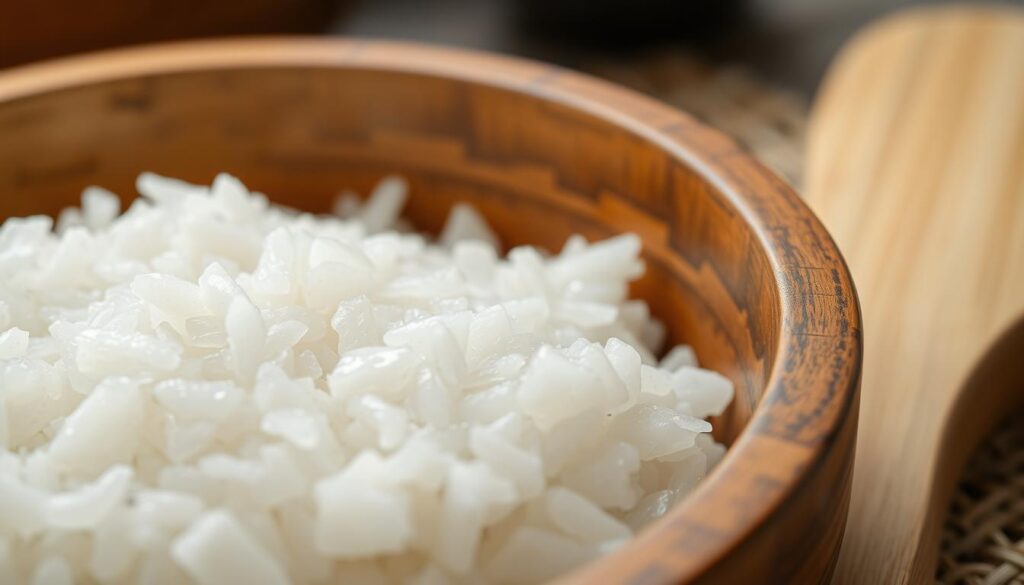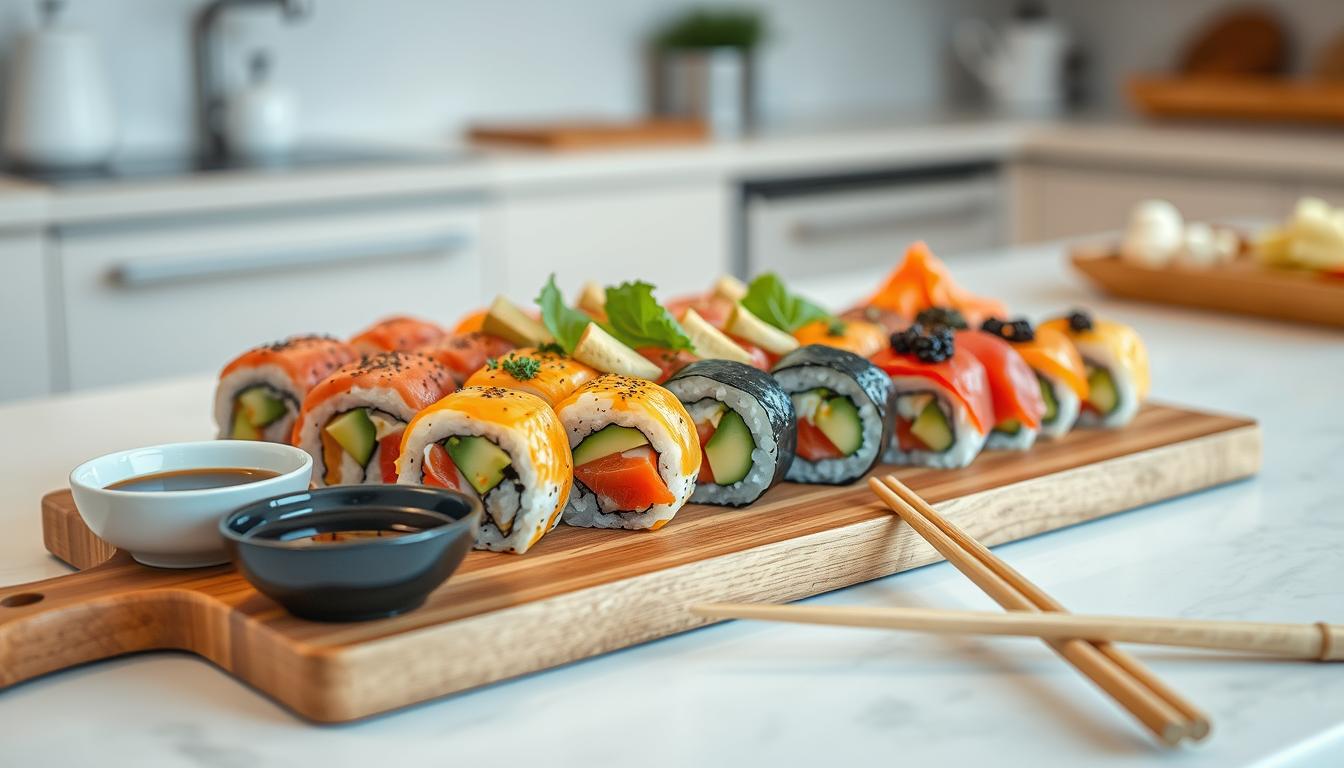Quick & Easy Sushi Roll Recipe 2025
Are you tired of spending too much on sushi at restaurants? Imagine making your own sushi rolls at home. With this quick and easy recipe, you can enjoy sushi without spending a lot.
Homemade sushi might seem hard, but it’s really simple with the right tools and techniques. This guide will show you how to make sushi rolls from scratch. You’ll use fresh ingredients from your local store.
Key Takeaways
- Discover the secrets to creating restaurant-quality sushi at home
- Learn the essential tools and equipment needed for sushi-making success
- Understand the art of preparing the perfect sushi rice
- Explore a variety of delicious filling combinations for your homemade sushi rolls
- Master the techniques for rolling sushi like a pro
Essential Sushi-Making Equipment and Tools
Making sushi at home needs a few key tools. As a sushi chef in training, the right tools are crucial. We’ll look at the basic tools every home sushi lover needs. We’ll also cover some extra equipment that can make your sushi prep even better.
Basic Tools Every Home Sushi Chef Needs
- A high-quality, sharp chef’s knife for slicing sushi ingredients with precision
- A rice cooker to ensure perfectly cooked, sticky sushi rice every time
- A bamboo sushi rolling mat for shaping and rolling your sushi rolls
- A sharp sushi knife or yanagiba for slicing your sushi rolls with a clean, even cut
- A sushi plate or boat for serving your beautifully presented sushi creations
Optional Equipment for Advanced Preparation
While the basics are key, some optional tools can enhance your sushi-making:
- A sushi prep station or workbench to provide ample space for cutting and rolling
- A sushi bazooka or mold for perfectly cylindrical and uniform sushi rolls
- A sushi platter or boat for elegant serving and presentation
- A sushi-grade fish slicer or sujihiki knife for delicate and precise fish cuts
Choosing the Right Bamboo Mat
The bamboo sushi rolling mat is vital for making perfect rolls. Look for a mat that’s tightly woven, durable, and easy to clean. Stay away from mats with loose or uneven strands. Also, pick a mat that fits the size of your sushi rolls.
With the right sushi rolling techniques and tools, you can make sushi like a pro at home. Enjoy the process, try out different tools, and let your creativity show in your sushi.

Understanding Sushi Rice: Preparation and Seasoning
Mastering Japanese cuisine begins with the sushi rice. This rice is crucial for making tasty homemade sushi rolls. It’s what makes your sushi as good as any restaurant’s.
Getting the sushi rice right is all about the details. You need short-grain rice, washed well, and cooked until it’s fluffy but slightly sticky. Then, mix it with rice vinegar, sugar, and salt. This gives it a sweet-and-sour taste that complements other sushi ingredients.
- Rinse the short-grain rice until the water runs clear, to remove any excess starch.
- Cook the rice according to the package instructions, using the optimal rice to water ratio for best results.
- In a small saucepan, combine rice vinegar, sugar, and salt, heating until the sugar dissolves.
- Gently fold the seasoned vinegar mixture into the cooked rice, using a rice paddle or wooden spoon to prevent the grains from becoming too sticky.
- Allow the seasoned rice to cool to room temperature before using it to assemble your sushi rolls.
By focusing on the details of sushi rice preparation and seasoning, you’re on your way to making authentic homemade sushi. It will truly capture the spirit of Japanese cuisine.

“Sushi is not just food, it’s an art form. The perfect sushi rice is the foundation for creating a masterpiece.”
Fresh Ingredients Selection for Perfect Sushi Rolls
To make sushi rolls that wow, picking the right ingredients is key. You need the best fish, seafood, veggies, and condiments. Each one is important for a great sushi taste.
Selecting the Best Fish and Seafood
The heart of a sushi roll is its fish or seafood. Choose the freshest, sashimi-grade options for the best taste. Tuna, salmon, yellowtail, shrimp, and scallops are popular picks. Make sure they’re sustainably sourced for quality and the planet.
Fresh Vegetables and Garnishes
- Crisp veggies like cucumber, carrots, and bell peppers add texture and freshness.
- Avocado is creamy and buttery, while herbs like cilantro or shiso add fragrance.
- Thinly sliced pickled ginger is salty and tangy, perfect for palate cleansing.
Essential Condiments and Sauces
| Condiment | Purpose |
|---|---|
| Soy Sauce | It adds a savory, umami flavor for dipping or drizzling. |
| Wasabi | It brings a fiery kick to balance the richness of the fish. |
| Eel Sauce | This sweet and savory sauce goes well with cooked or grilled proteins. |
By picking the freshest ingredients and the right condiments, you’ll make sushi rolls that look great and taste amazing.
Quick & Easy Sushi Roll Recipe: Step-by-Step Guide
Want to enjoy sushi without the fuss? Our quick and easy sushi roll recipe is here for you. It’s perfect for those new to sushi. Follow these easy steps to make tasty quick & easy sushi roll recipe and simple sushi rolls at home.
- Prepare the sushi rice as instructed earlier.
- Lay a sheet of nori (seaweed) shiny side down on a bamboo mat.
- Spread a thin layer of sushi rice evenly over the nori, leaving a small gap at the top.
- Arrange your desired fillings, such as cucumber, avocado, or tuna, in a horizontal line near the center of the rice.
- Using the bamboo mat, gently roll the nori and rice over the filling, forming a tight cylinder.
- Moisten the exposed nori with a bit of water to seal the roll.
- Slice the roll into 6-8 pieces using a sharp, wet knife, and serve with soy sauce, wasabi, and pickled ginger.
Follow these simple steps to make delicious quick & easy sushi roll recipe and simple sushi rolls. They’ll wow your family and friends. Try different fillings and explore sushi-making at home!
Mastering Basic Rolling Techniques
Making the perfect sushi roll needs a few key techniques. Whether you’re new to sushi or want to get better, learning inside-out and traditional methods is key. You’ll be able to make beautiful, top-notch sushi at home.
Inside-Out Roll Method
The inside-out roll, or “California roll,” is perfect for beginners. Here’s how to do it:
- Lay a sheet of nori (seaweed) shiny-side down on a bamboo rolling mat.
- Spread a thin layer of sushi rice over the nori, leaving a small border at the top.
- Flip the nori over so the rice is facing down.
- Arrange your desired fillings in a line across the center of the nori.
- Using the bamboo mat, tightly roll the nori around the fillings, starting from the bottom and working your way up.
- Gently squeeze the roll to compact it, then slice into bite-sized pieces.
Traditional Roll Technique
For a more authentic sushi roll, try the traditional method. Follow these steps:
- Place a sheet of nori shiny-side up on the bamboo mat.
- Spread a thin layer of sushi rice over the nori, leaving a small border at the top.
- Arrange your fillings in a line across the center of the rice.
- Using the bamboo mat, tightly roll the nori around the fillings, starting from the bottom and working your way up.
- Gently squeeze the roll to compact it, then slice into bite-sized pieces.
Troubleshooting Common Rolling Problems
Having trouble with your sushi roll? Try these tips:
- The roll is falling apart: Make sure your rice is properly seasoned and sticking together. Also, be gentle but firm when rolling and slicing the sushi.
- The roll is too tight or difficult to slice: Loosen your grip on the bamboo mat and allow the roll to expand slightly before slicing.
- The fillings are spilling out: Arrange the fillings in a compact, even line before rolling. Avoid overstuffing the roll.
With a bit of practice, you’ll soon be making delicious sushi rolls like a pro. Enjoy your homemade beginner sushi recipe!
Popular Filling Combinations for Beginners
Starting your sushi-making journey is exciting. You’ll get to try out different sushi ingredients and make tasty simple sushi rolls. Whether you love sushi or want to try something new, there are many great fillings to explore.
The California roll is a great choice for beginners. It has imitation crab, avocado, and cucumber. This roll is loved by many because it shows how flavors and textures work well together in sushi.
- California roll: Imitation crab, avocado, cucumber
- Spicy tuna roll: Spicy tuna, cucumber, sesame seeds
- Cucumber roll: Cucumber, rice, nori
- Avocado roll: Avocado, rice, nori
- Philadelphia roll: Smoked salmon, cream cheese, cucumber
If you’re feeling bold, try the spicy tuna roll. It’s spicy and fresh at the same time. The Philadelphia roll is another option, with smoked salmon and cream cheese. For vegetarians, the cucumber and avocado rolls are refreshing and tasty.
Trying these simple sushi rolls is a great way to improve your skills. You’ll find new flavors you love. Making sushi is all about trying new things and creating beautiful, tasty rolls for your loved ones.
Making Vegetarian and Vegan Sushi Options
In the world of sushi, there’s a growing demand for plant-based options. These cater to vegetarian and vegan diners. Making delicious and healthy vegetarian sushi rolls is easier than you might think. By using plant-based protein alternatives and creative vegetable combinations, you can make sushi that’s both tasty and nutritious.
Plant-Based Protein Alternatives
For vegetarian sushi rolls, protein-rich plant-based options are key. They provide the needed substance and texture. Here are some ingredients to consider:
- Tofu: Firm or extra-firm tofu can be sliced, marinated, and rolled into sushi.
- Tempeh: This fermented soybean cake offers a dense, meaty texture that works well in sushi.
- Avocado: Creamy and satisfying, avocado is a versatile ingredient that can substitute for traditional fish or seafood.
- Edamame: These young, tender soybeans add a pop of color and protein to your sushi.
Creative Vegetable Combinations
Vegetables are key in making healthy sushi options. Try different fresh, crunchy, and flavorful veggies for your vegetarian sushi rolls. Here are some ideas:
- Cucumber: Sliced thin, cucumber adds a refreshing element to your sushi.
- Carrots: Grated or julienned, carrots provide a vibrant pop of color and natural sweetness.
- Bell peppers: Sliced into thin strips, bell peppers offer a delightful crunch and a burst of flavor.
- Mushrooms: Sautéed or marinated, mushrooms can lend an earthy, savory note to your sushi.
- Spinach or kale: These nutrient-dense greens add a fresh, leafy component to your rolls.
By exploring plant-based proteins and creative vegetable combinations, you can make vegetarian sushi rolls that look great and taste amazing. Dive into the world of healthy sushi options and let your creativity shine!
Storage Tips and Food Safety Guidelines
Keeping your homemade sushi fresh is key. Whether you have leftovers or just made a batch, storing them right is important. Here are some tips to keep your homemade sushi and sushi ingredients fresh and tasty.
Storing Sushi Rolls
- Wrap each sushi roll in plastic wrap or use an airtight container before refrigerating.
- Keep sushi rolls in the fridge at 40°F (4°C) or below. Eat them within 3-4 days for the best taste and safety.
- Don’t let sushi rolls sit at room temperature for over 2 hours. This can cause bacteria to grow.
Handling Raw Fish and Seafood
When working with raw fish and seafood, be extra careful for food safety:
- Buy fresh, quality fish from a trusted source and refrigerate it right away.
- Wash your hands well with soap and water before and after touching raw fish.
- Use different cutting boards and tools for raw fish to prevent contamination.
- Cook fish or seafood to 145°F (63°C) to kill harmful bacteria.
Storing Sushi Ingredients
Storing your sushi ingredients properly keeps them fresh and good:
- Put raw fish and seafood in the coldest part of your fridge at 40°F (4°C) or below.
- Store cooked rice, veggies, and other ready ingredients in airtight containers in the fridge.
- Mark and date all stored items so you use them before they go bad.
By following these storage and food safety tips, you can enjoy your homemade sushi with confidence and peace of mind.
Serving and Presentation Ideas
When serving your homemade sushi, how it looks is just as key as how it tastes. There are many ways to make your sushi stand out, from traditional Japanese styles to modern twists. Learn how to enhance your japanese cuisine and sushi making tutorial with these tips.
Traditional Plating Methods
In japanese cuisine, how you present your sushi matters a lot. Use old techniques to show off your sushi in a classy and true-to-form way. Place your rolls on a simple plate, letting their colors and textures be the main attraction.
Add traditional sides like pickled ginger, wasabi, and soy sauce. Place them thoughtfully to create a balanced look.
Modern Presentation Styles
For a fresh take on sushi, try new plating ideas. Use slate or wood boards and add edible flowers or micro-greens for interest. Try serving in bamboo boats or modern platters for a stunning look.
Garnishing Techniques
- Thin slices of cucumber, radish, or carrot add color and crunch.
- Toasted sesame seeds or furikake give flavor and texture.
- Edible flowers like nasturtiums or marigolds make a beautiful and Instagram-worthy touch.
- Drizzle with eel sauce, spicy mayo, or ponzu for a fancy finish.
Mastering sushi presentation turns your homemade sushi into art. It will impress your guests and make your japanese cuisine and sushi making tutorial even better.
Conclusion
In this article, you’ve learned how to make tasty sushi rolls at home. You now know the key tools and how to prepare sushi rice. You also know how to pick the right ingredients.
Whether you’re new to sushi or want to get better, this guide has you covered. It offers step-by-step instructions and tips to help your sushi turn out great. Soon, you’ll be making sushi that will wow your loved ones.
Making sushi at home is all about the journey. It’s about the hands-on fun, trying new flavors, and making something beautiful. So, start making sushi today. Enjoy every step, taste the deliciousness, and be proud of your creations.
FAQ
What are the essential tools and equipment needed to make sushi at home?
To make sushi at home, you need a few basic tools. These include a rice cooker, sharp knife, and a bamboo mat. You also need some other key items. While there are optional advanced tools, these basics are enough to start.
How do I prepare and season sushi rice properly?
Preparing sushi rice is key. You must rinse the rice, cook it right, and season it correctly. This ensures the rice has the right texture and flavor.
What are some tips for selecting the freshest ingredients for sushi?
For great sushi, choose fresh fish and seafood. Pick the best vegetables, condiments, and other ingredients too. Follow guidelines for sourcing and handling to keep your sushi safe and tasty.
How do I roll sushi properly at home?
Learning to roll sushi takes practice, but it’s doable. We’ll teach you the inside-out roll method and traditional techniques. We’ll also give you tips to help you roll like a pro.
What are some easy and tasty sushi roll fillings for beginners?
Beginners can start with simple yet tasty fillings. Try classic tuna and cucumber or creative vegetable rolls. We’ll give you a list of popular fillings to get you started.
How can I make vegetarian and vegan sushi options at home?
You can make delicious vegetarian and vegan sushi. Use plant-based proteins and fresh vegetables. We’ll share ideas for tasty meat-free sushi.
How do I properly store and handle homemade sushi for food safety?
Food safety is crucial when making sushi at home. We’ll guide you on how to store and handle your sushi. This keeps it fresh and prevents foodborne illness.
How can I present my homemade sushi in an appetizing way?
Sushi is as much about looks as taste. We’ll show you traditional and modern ways to present your sushi. This will make your homemade rolls look and taste great.
Did You Our Pizza?
There are no reviews yet. Be the first one to write one.

